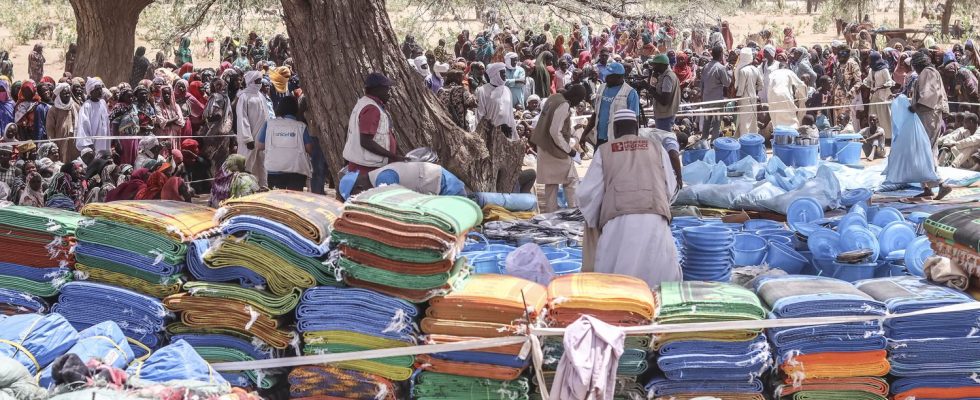The United Nations High Commissioner for Refugees expects “more than 800,000 people” to move within the country or to neighboring states such as Egypt or Chad.
Will the truce slow down population movements? Leaders of Sudan’s warring army and paramilitary forces agreed on Tuesday (2 May) to a seven-day pause in fighting from 4 to 11 May. So far, none of the previous truces has been respected. The fighting, which began on April 15, left more than 500 dead and thousands injured. The conflict has plunged the country, one of the poorest in the world, into a “real disaster”, according to the UN. Hundreds of thousands of people are fleeing violence inside Sudan and in neighboring countries. The United Nations High Commissioner for Refugees (UNHCR) says it expects “more than 800,000 people” are moving. Franceinfo takes stock of the situation in Sudan.
In Sudan, more than 330,000 displaced
According to the International Organization for Migrants (IOM), more than 334,000 people have fled the fighting inside Sudan. These are mainly migrations in the states of Khartoum, North, Blue Nile, North Kordofan, North Darfur, West Darfur and South Darfur, completes the UN.
International organizations are particularly concerned about the situation in Darfur. This region of western Sudan has been the scene of a civil war since 2003 and the humanitarian situation there remains disastrous, recalls Amnesty International. UNHCR fears that these clashes are fueling pre-existing ethnic and inter-communal tensions, over land and access to resources, and causing further displacement.
Before the fighting began on April 15, there were already 3.7 million internally displaced people in Sudan, most of them in West Darfur.
In Chad, 30,000 refugees have arrived
The United Nations High Commissioner for Refugees estimates that 30,000 people have arrived in Chad, of whom more than 21,000 have been identified so far. “We are continuing verification and registration operations”said a spokeswoman for the UN agency.
In early May, at least 20,000 people sought refuge in a makeshift camp in the Chadian village of Koufroun, according to UNHCR. Coming by donkey, on horseback, on carts or on foot, these refugees are overwhelmingly women and children. They come from the small Sudanese town of Tendelti, about twenty kilometers from Koufroun.
In Koufroun, Unicef distributes emergency kits with kitchen utensils, blankets and mats. The NGO Première urgence internationale has set up a makeshift medical unit there. Three health workers offer consultations, first to all women, children and the elderly. “The main pathologies are respiratory diseases, gastroenteritis and malnutrition”explains the head of the NGO on the spot, interviewed by AFP.
Thousands of other refugees are still at risk of arriving in Koufroun, and elsewhere in Chad, as more than 1,300 km of extremely porous border separates the two countries. Already, before April 15, 400,000 Sudanese refugees were living in Chad in 13 camps and within local communities.
In Egypt, 40,000 people entered
Some 40,000 Sudanese have also arrived in Egypt, UNHCR reports. But only bus travel with special permits is allowed to cross the border and crossing on foot is prohibited, says the BBC (in English). According to the British media, many families were stranded at the border, as bus drivers demanded nearly 40,000 dollars (about 36,000 euros) to cross the border. In Liberation (paid item)a Sudanese refugee from Khartoum says she paid 400 euros for her bus seat.
Near Aswan in Egypt, associations and the local population are mobilizing to help refugees. “The inhabitants opened their schools, their mosques and even their houses to us to sleep”says a newcomer to Release. On social networks, Egyptian Internet users call to welcome refugees without conditions, under the hashtag “For the entry of Sudanese without a visa”.
On the spot, aid is provided by the United Nations and distributed by the Egyptian Red Crescent. A first emergency aid contains dry food, medical and telecommunications services and logistical assistance for people who have difficulty moving around.
In South Sudan, more than 20,000 displaced
A total of 27,275 people have arrived in South Sudan, according to UNHCR. The majority (20,932) are South Sudanese. There are also 2,679 Sudanese as well as 3,364 nationals of other countries. People arriving at the border are elderly people, people with disabilities, pregnant women, women with young children and large families.
The United Nations High Commissioner for Refugees states on its website that it has set up a transit center where new arrivals can receive emergency relief and benefit from child protection services, family reunification and to contact their family and plan the rest of their trip.
This new influx of refugees adds to the million displaced already present in the country due to the war that has ravaged the country since 2013, recalls Doctors Without Borders. Settled in camps, the refugees have only very limited access to drinking water, sanitation facilities and health structures. They constantly face threats of theft, looting and sexual violence, warns the NGO.
In Ethiopia, more than 8,000 refugees
Some 8,900 people have fled to Ethiopia, including 870 Sudanese. UNHCR has deployed teams at the two main border crossing points in Amhara and Benshangul-Gumuz regions. For decades, Ethiopia had already hosted nearly 990,000 refugees from neighboring countries such as South Sudan, Somalia, Eritrea and Sudan, recalls the UN.
In the Central African Republic, approximately 6,000 refugees
UNHCR estimates that around 6,000 refugees have now crossed the Central African border, where the organization has deployed an emergency team. Refugee registration is expected to begin soon and resettlement assessments are underway to move refugees away from the border and into safer locations. These displacements lead to an increase in the price of food, warns the UN. For example, a 50 kg bag of sugar, which sold for 40,000 CFA francs (over $65) before the conflict, is now worth 80,000 CFA francs ($134) in Birao.
